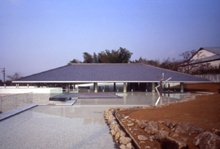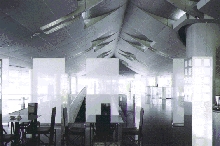

|
Nara, Japan
Design/Construction 1989-1991
Building Area: 664.09m²
Total Floor Area: 2,313.99m²
Reinfored Concrete(basements), Steel Structure
2 Basement Floors + 1 Storey
The Nara city Museum of Photography was built by the city of Nara to house the negatives of images and a personal collection of work received as a gift from the late photographer Yasukichi Irie, a resident of Nara who captured the town and Buddhist images on film throughout his life.
The museum is located adjacent to Shinyakushiji Temple, which has been designated a National Treasure. Nearby is the campus of Nara University of Education and an encroaching residential zone, but the area remains resplendent for it retains the characteristic Nara landscape and atmosphere.
The policies of the Agency for Cultural Affairs, Nara Prefecture and the city of Nara concerning construction in areas adjacent to local historical structures has not been codified into law, but it was required for this project that roofing tiles similar to those of the Nara Period be used. Other recent examples of buildings also completed with such "guidance" requiring the use of tiled roofs are the Nara Prefectural Park Hall by Kiyonori Kikutake and the Nara Ken New Public Hall. These are but two of various examples.
Since the museum building is located much closer to Shinyakushiji Temple than the example mentioned above, it was only natural to present a plan that called for the use of such roofing tiles.
It was extremely fortunate that the land was one level lower than that of Shinyakushiji Temple, but that is still not sufficient. We studied vista simulations and models and, after much deliberation, the final plan called for nearly the entire art museum to be built underground.
On top of this underground art museum we placed a roof that looked as if it were suspended from the heavens. The first floor would contain only the entrance hall and tea room, and all four walls would be made of glass to emphasize the feeling of lightness and transparency.
Seen from the outside, the intended effect with the transparent glass was for the room to look as if it were floating, since only the roof would be visible.
For the roof, a tile similar to that used in the Nara period would be employed, and on the underside (the first floor ceiling) metallic plating was incorporated in a modern design to resemble an airplane wing. The method was akin to the use of a series of overlapping linings to accent a kimono. For the curved portions of the tiled roof, although roofing of the Nara Period was used as a reference, we employed the modern crossoid curve.
* Building Constructors Society Award, 1991
* Prize of Japan Art Academy, 1992
|
|
